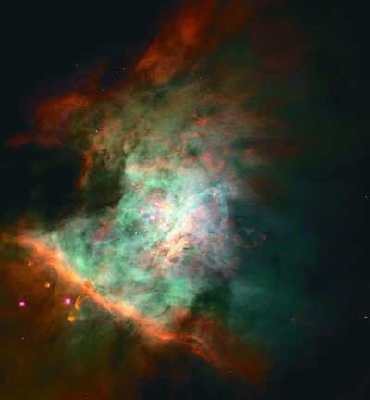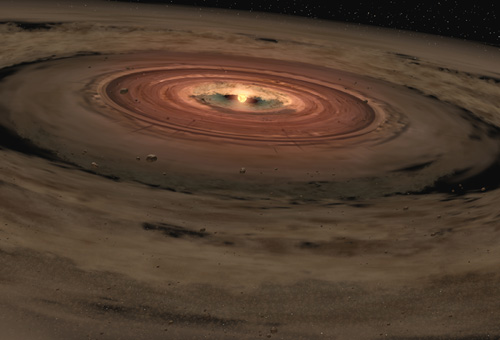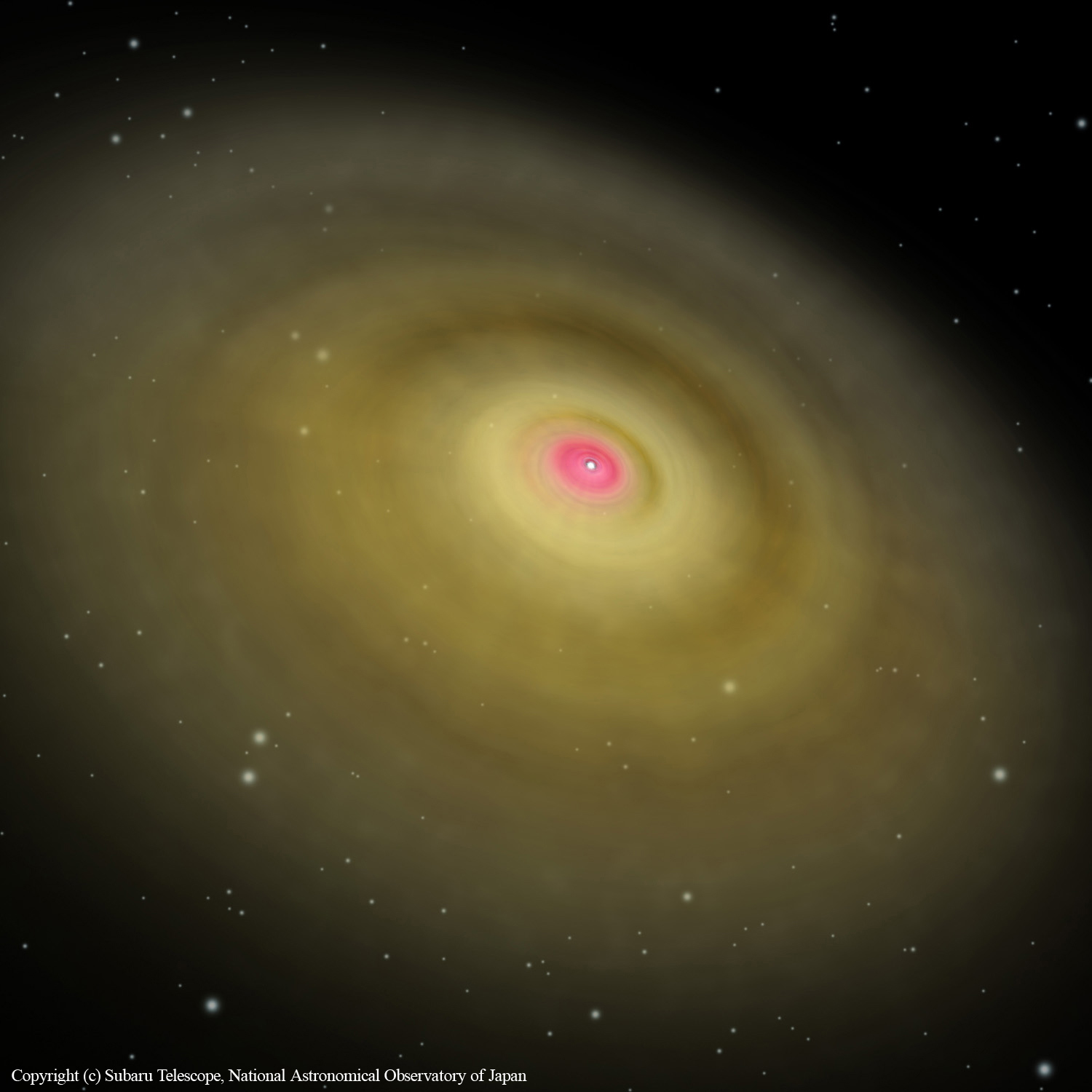A little closer to home - Planets

Our solar system formed from a giant cloud of gas and dust like this one -- the Orion Nebula.
Image courtesy NASA/STScI.
In past e-mail "lessons" we talked about BIG stuff in Astronomy; cosmology, measuring huge distances, tools and hardware. Most of what we know about the Universe is stuff much closer; our Solar System. Now that we "know" how to make a Universe, let's discuss how to make planets!
Remember that in the past I told you that you are made of "Star Stuff". The first many million years after the Big Bang saw a universe with only Hydrogen and Helium (and maybe a tiny bit of Lithium); the simplest elements. Obviously you can't make a "rocky" planet like Earth out of just Hydrogen and Helium. To make heavier elements you have to smash Hydrogen and Helium atoms together. The only place to do this is in the center of stars - this is what powers the star and makes it shine. Once the heavier elements are in the center of the star, the only way to get them out is to explode the star! Only very big (massive) stars (more than about 8 times more massive than our Sun) can go Super-Nova. The early universe had lots of Hydrogen in a relatively small volume so lots of BIG stars formed early. The bigger the star the faster it "burns" its fuel and the sooner it goes BOOM! The big stars in the early universe only lived for a few *m*illion years (small suns like ours live for many *B*illions of years). When these big suns explode they spread huge amounts of all the elements known - hydrogen to uranium - out into space. The rather "lumpy" looking galaxies of the early universe started with lots of big fast burning "first generation" stars that blew up and filled the galaxies with huge clouds of dust and gas that became the raw material for "second generation" stars like the stars we see near us in our Milky Way galaxy. When we look at the spectra (remember those Fraunhofer lines?) of the very farthest galaxies we can see (and remember that we are looking back in TIME since it takes time for the light to reach us) only hydrogen and helium lines. As we look at closer and closer galaxies, we see more and more Fraunhofer lines of heavier elements and, hence, more and more second generation stars. In our own galaxy, all stars must be at least about 13 billion years old (that's about the age of the universe). Any star that is 13 billion years old must be very small to still have fuel left (remember - the bigger the star the faster it uses up it's fuel). Any star that small would also be very dim and hard to see. We don't see any stars like that around us. All are neighbors are made up of materials that have already been through at least one star that has blown up. We are made of star-stuff and so are all our neighbors!
So, how does the debris from a blown-up star become a new star?
Remember that stars that blow up are very massive stars - at least 8 times as massive as our sun. When the star blows up, huge amounts of mass are changed into energy in a very few minutes. This mass converted to energy (E=mc² remember), while a lager amount, is a tiny fraction of the total mass of the star. That means there is still may be 8 solar masses of debris left when the star goes boom - enough to make 8 solar systems like ours.
If several huge "first generation" stars all blow up in the same general area (a very likely situation), we end up with some enormous clouds of gas and dust hanging around loosely held together by gravity (a "nebula"). Most of this is still hydrogen and helium but there is a fairly large percentage of heavier elements all the way up to Uranium.
Now, having big clouds of gas and dust with enough mass for hundreds of solar systems is a great starting point but getting all this stuff to actually clump together to make a star is a bit tricky. The gas and dust is often pretty fast moving (which is another way of saying it is hot) and it doesn't want to "stick together". Astronomers think there needs to be an outside force that condenses some of the dust and gas into a "lump". Once you have a lump of stuff, gravity will pull more gas and dust to it and make it bigger and bigger. One possible outside force might be yet another nearby star going nova. The shock wave and expanding debris field could compress the material in a neighboring gas/dust nebula into forming a proto stellar core - the lump in the middle of a new star.
You might remember that when a star goes nova, a pretty good sized chunk of the original star survives as neutron star (a star made of nothing but Neutrons - those chargeless particles in the middle of atoms) and doesn't become part of the debris field. If a fast moving nova remnant neutron star blunders through a big gas/dust nebula it will cause swirlies (eddies and vorticies) of gas and dust that also might clump together to form the center of the new star.
How does having a clump of stuff make not just a star, but planets?
We know that stars now form from the debris of previously exploded stars. The gas and dust probably gets swirled into eddies by a passing star or a nearby nova. Now here comes a trick. If left to itself, a cloud of gas or dust will, at best, form a sphere. If the cloud is disturbed by a star passing through (or a HUGE spoon), the path behind the star leaves a big eddy (and lots of little smaller eddies). The eddy will always make the dust/gas spin about some axis. Whatever dust/gas is moving the fastest will move out the farthest from the central axis and and the slow moving stuff will stay close to the axis. Eventually all the gas/dust of the same speed ends up at the same distance from the center and you end up with a "stable" rotating cylinder of dust/gas. All the dust at the same distance from the center will be attracted by gravity to each other and the cylinder will slowly collapse into a thick rotating disk like a Frisbee with a bulge in the middle. This disk will be HUGE! It will be much larger in diameter than our entire solar system - out beyond Pluto and millions of kilometers thick and have a mass of many many times our sun. This huge rotating mass will also gravitationally "pull" in more gas and dust from the surrounding cloud.
Let's think about what things are like in this disk. For the most part, everything is rotating in the same direction (anything coming from the "outside" that isn't going in the direction everything else is will soon smack into something and, after a couple of collisions, will be headed in the right direction or expelled from the disk. Since everything is rotating the same way and since everything that is about the same distance from the center of rotation is moving a the same speed, that means that any two close together particles are pretty much stationary relative to each other. Gravity or any electrical charge may bring stuff together and, barring outside collisions, they will stay together. As soon as a few particles start forming, their gravitational attraction increases so more dust and other particles are drawn in. Little by little "lumps" form - the bigger they are the faster they grow. This is called "accretion" and we are making "planetesimals".

